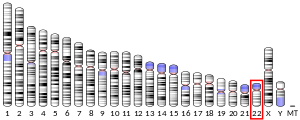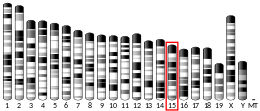HDAC10
Appearance
Histone deacetylase 10 is an enzyme that in humans is encoded by the HDAC10 gene.[5][6][7] HDAC10 is a class IIb HDAC. It specifically has selectivity for long, slender polyamines like N8-acetylspermidine. [8]
Acetylation of histone core particles modulates chromatin structure and gene expression. The opposing enzymatic activities of histone acetyltransferases and histone deacetylases, such as HDAC10, determine the acetylation status of histone tails (Kao et al., 2002).[supplied by OMIM][7]
Interactions
[edit]HDAC10 has been shown to interact with Histone deacetylase 2[9] and Nuclear receptor co-repressor 2.[9]
See also
[edit]References
[edit]- ^ a b c GRCh38: Ensembl release 89: ENSG00000100429 – Ensembl, May 2017
- ^ a b c GRCm38: Ensembl release 89: ENSMUSG00000062906 – Ensembl, May 2017
- ^ "Human PubMed Reference:". National Center for Biotechnology Information, U.S. National Library of Medicine.
- ^ "Mouse PubMed Reference:". National Center for Biotechnology Information, U.S. National Library of Medicine.
- ^ Kao HY, Lee CH, Komarov A, Han CC, Evans RM (January 2002). "Isolation and characterization of mammalian HDAC10, a novel histone deacetylase". The Journal of Biological Chemistry. 277 (1): 187–193. doi:10.1074/jbc.M108931200. PMID 11677242.
- ^ Guardiola AR, Yao TP (February 2002). "Molecular cloning and characterization of a novel histone deacetylase HDAC10". The Journal of Biological Chemistry. 277 (5): 3350–3356. doi:10.1074/jbc.M109861200. PMID 11726666.
- ^ a b "Entrez Gene: HDAC10 histone deacetylase 10".
- ^ Lambona C, Zwergel C, Fioravanti R, Valente S, Mai A (October 2023). "Histone deacetylase 10: A polyamine deacetylase from the crystal structure to the first inhibitors". Current Opinion in Structural Biology. 82: 102668. doi:10.1016/j.sbi.2023.102668. PMID 37542907.
- ^ a b Fischer DD, Cai R, Bhatia U, Asselbergs FA, Song C, Terry R, et al. (February 2002). "Isolation and characterization of a novel class II histone deacetylase, HDAC10". The Journal of Biological Chemistry. 277 (8): 6656–6666. doi:10.1074/jbc.M108055200. PMID 11739383.
Further reading
[edit]- Bonaldo MF, Lennon G, Soares MB (September 1996). "Normalization and subtraction: two approaches to facilitate gene discovery". Genome Research. 6 (9): 791–806. doi:10.1101/gr.6.9.791. PMID 8889548.
- Dunham I, Shimizu N, Roe BA, Chissoe S, Hunt AR, Collins JE, et al. (December 1999). "The DNA sequence of human chromosome 22". Nature. 402 (6761): 489–495. Bibcode:1999Natur.402..489D. doi:10.1038/990031. PMID 10591208.
- Fischer DD, Cai R, Bhatia U, Asselbergs FA, Song C, Terry R, et al. (February 2002). "Isolation and characterization of a novel class II histone deacetylase, HDAC10". The Journal of Biological Chemistry. 277 (8): 6656–6666. doi:10.1074/jbc.M108055200. PMID 11739383.
- Tong JJ, Liu J, Bertos NR, Yang XJ (March 2002). "Identification of HDAC10, a novel class II human histone deacetylase containing a leucine-rich domain". Nucleic Acids Research. 30 (5): 1114–1123. doi:10.1093/nar/30.5.1114. PMC 101247. PMID 11861901.
- Rodriguez M, Yu X, Chen J, Songyang Z (December 2003). "Phosphopeptide binding specificities of BRCA1 COOH-terminal (BRCT) domains". The Journal of Biological Chemistry. 278 (52): 52914–52918. doi:10.1074/jbc.C300407200. PMID 14578343.
- Hillman RT, Green RE, Brenner SE (2005). "An unappreciated role for RNA surveillance". Genome Biology. 5 (2): R8. doi:10.1186/gb-2004-5-2-r8. PMC 395752. PMID 14759258.
- Osada H, Tatematsu Y, Saito H, Yatabe Y, Mitsudomi T, Takahashi T (October 2004). "Reduced expression of class II histone deacetylase genes is associated with poor prognosis in lung cancer patients". International Journal of Cancer. 112 (1): 26–32. doi:10.1002/ijc.20395. PMID 15305372. S2CID 23452893.
- Collins JE, Wright CL, Edwards CA, Davis MP, Grinham JA, Cole CG, et al. (2005). "A genome annotation-driven approach to cloning the human ORFeome". Genome Biology. 5 (10): R84. doi:10.1186/gb-2004-5-10-r84. PMC 545604. PMID 15461802.
External links
[edit]- HDAC10+protein,+human at the U.S. National Library of Medicine Medical Subject Headings (MeSH)
This article incorporates text from the United States National Library of Medicine, which is in the public domain.




